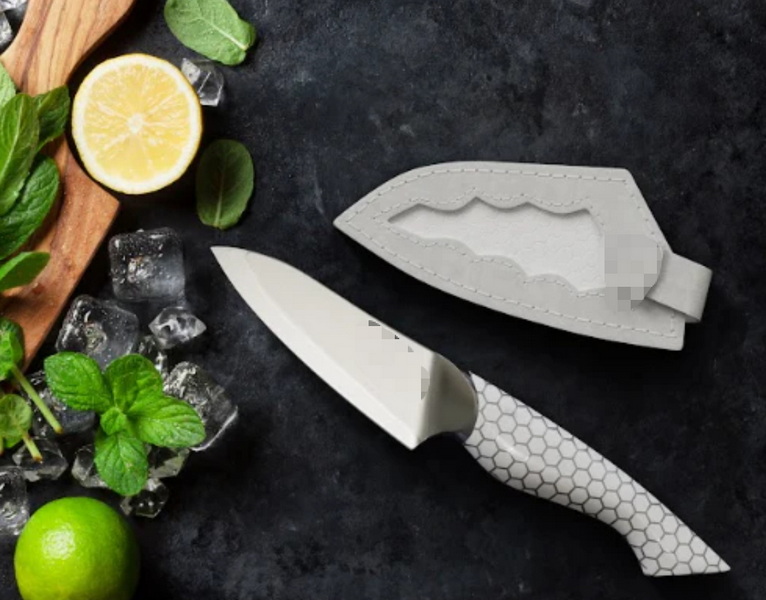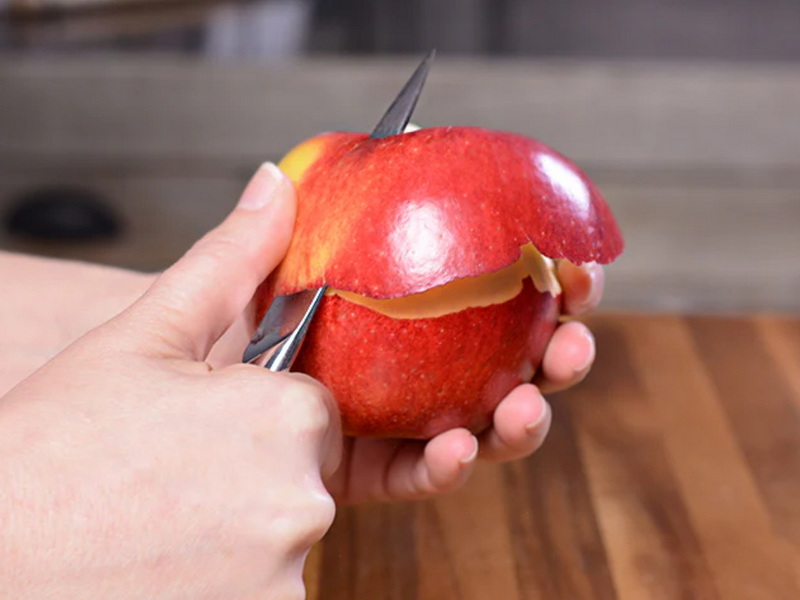- All
- Product Name
- Product Keyword
- Product Model
- Product Summary
- Product Description
- Multi Field Search
Views: 222 Author: Ann Publish Time: 2025-10-24 Origin: Site











Content Menu
● Blade Geometry and Edge Styles
>> Pointed Tips vs. Rounded Tips
>> Blade Rockwell and Hardness
>> Damascus and Composite Blades
>> Handle Materials and Ergonomics
>> Grip Styles
>> Weight Distribution and Balance
>> Safety Tips for Delicate Fruit Carving
● How to Choose the Best Paring Knife for Your Needs
>> Techniques and Carving Ideas
● Common Mistakes and How to Avoid Them
● Maintenance Tips for Peak Performance
● FAQ
>> What is the best Paring Knife material for fruit carving?
>> How do I maintain a Paring Knife to keep it sharp for carving?
>> What blade length is best for intricate garnishing?
>> How should I hold a Paring Knife to maximize control?
>> Can a Paring Knife be used for peeling citrus skins without tearing the fruit?
In professional kitchens and discerning home setups, a high-quality Paring Knife is an indispensable tool for fruit carving and garnishing. The right Paring Knife enables precise peels, delicate trims, and intricate details that elevate plate presentation from ordinary to stunning. Blade geometry, blade material, and handle design all influence control, safety, and aesthetics. This guide dives into blade shapes, materials, sizes, ergonomics, maintenance, and practical choosing criteria, with actionable tips for selecting the best Paring Knife for your carving and garnishing needs.

A Paring Knife is a small, versatile blade designed for precision work. Typically ranging from 3.0 to 4.5 inches in length, it excels at peeling, trimming, scoring, deseeding, and creating intricate fruit carvings and garnishes. Unlike larger chef or utility knives, the Paring Knife offers unmatched control for detail work, making it the go-to instrument for eyes, petals, and delicate floral motifs in fruit presentation.
- Pointed tips provide precision for fine details, such as carving tiny leaves, delicate petals, and initiating precise curves.
- Rounded tips reduce the risk of accidental punctures and are favored for broader shaping and gentle scooping tasks.
- Plain edge blades are common for everyday carving, offering predictable feedback and ease of sharpening.
- Micro-serrated edges can grip slippery fruit skins, aiding in initial cuts without tearing.
- Single bevel blades emphasize one-sided sharpness for highly controlled, clean lines; double bevel blades offer balanced performance for general carving tasks.
- Higher hardness can improve edge retention but may demand more careful sharpening to avoid chipping, especially on delicate fruit skins.
- For fruit carving, a balance between hardness and toughness is ideal to handle thin slices and thin-walled fruits without micro-chipping.
Stainless Steel vs. Carbon Steel
- Stainless steel resists corrosion and staining, forgiving in humid kitchen environments; it maintains a reasonable edge and is easier to maintain.
- Carbon steel can take a sharper edge and offer excellent point retention, but it requires diligent drying and oiling to prevent rust.
- Damascus or layered blades provide striking visual appeal and can deliver balanced performance with good edge geometry.
- For fruit carving, the aesthetic appeal of Damascus blades can inspire more elaborate designs, though practical performance depends on alloy quality and heat treatment.
- G10 and pakkawood offer excellent grip in moist conditions and can be shaped for comfortable, secure handling.
- Synthetic composites and resin-based handles provide durability and moisture resistance, with a wide range of texture options for slip resistance.
- Ergonomics matter: rounded ferrules, contoured scales, and balanced tang contribute to reduced fatigue during long carving sessions.
- Full tang blades generally provide superior balance and control, especially for long carving sessions where precision matters.
- Partial tangs can be lighter but may feel less secure in light, repetitive carving tasks.
- Best for micro-detail work, such as removing seeds from small fruits, making curved indentations, and fine peelings on citrus segments.
- The most versatile size for fruit carving and garnishing, accommodating a wide range of fruits from apples to kiwis.
- Suited for larger fruits and broader slices or petals, enabling longer strokes with maintained precision.

- Pinch grip: allows maximum control for precise cuts and is favored by professional carvers.
- Full-hand grip: provides stability for longer sessions; ensure the handle shape accommodates a secure palm grip.
- A well-balanced Paring Knife reduces hand fatigue and improves control when performing delicate curves and slicing motions.
- Keep the blade sharp; a dull blade increases the risk of slips.
- Use controlled pressure and gradual deceleration when approaching the cut line.
- Maintain a dry working surface and dry the blade frequently to prevent slips caused by moisture.
Cleaning and Drying
- Hand wash with mild detergent and warm water; dry immediately to prevent rust and staining.
- Avoid dishwasher exposure, which can degrade wood handles and corrosion-resistant coatings.
- Regular honing helps maintain edge alignment between sharpenings.
- Periodic sharpening is essential; use appropriate stones or systems compatible with the blade material.
- Magnetic strips and knife blocks offer convenient, accessible storage while minimizing blade dulling.
- Protective sheaths or blade covers safeguard the edge during transport and storage.
- Blade material and hardness: balance sharpness, edge retention, and corrosion resistance.
- Edge retention and ease of sharpening: consider the available sharpening tools and facilities.
- Blade geometry for fruit carving: prioritize shape and tip design for your carving style.
- Handle comfort and grip in wet conditions: ensure a secure, confident hold.
- Weight and balance: select a knife that reduces fatigue during extensive carving.
- Maintenance commitments: align the blade material and construction with your upkeep capabilities.
- Test cuts on citrus, apples, kiwis, mangos, and other carving-media fruits.
- Evaluate control, feedback, and edge smoothness, particularly at the tip and the heel.
- Assess how the knife navigates curved lines and tight corners without tearing fruit skin.
Basic Techniques
- Peeling, trimming cores, segmenting fruits, and creating thin curved lines for leaves and petals.
- Scoring delicate patterns with light pressure to avoid tearing.
- Floral carvings: orange blossoms, apple roses, citrus petals.
- Garnishes: fruit baskets, spirals, ribbons, and edible lace patterns.
- Dull blades causing slips and tearing.
- Overly aggressive pressure leading to jagged cuts.
- Overreaching for ambitious motifs beyond blade capability.
- Poor hygiene affecting fruit color and presentation due to browning or contamination.
- Wipe blade dry after use, store properly, and ensure the knife is not left in damp conditions.
- Inspect the edge for micro-burrs and address them with a quick honing pass.
- Schedule sharpening sessions appropriate to blade material and usage level.
- Clean and condition wooden handles as required to maintain grip and longevity.
A high-quality Paring Knife significantly enhances fruit carving and garnishing by delivering precise control, clean edge lines, and ergonomic comfort. By selecting the right blade geometry, material, and handle design, you achieve cleaner peels, more intricate motifs, and more consistent presentation across dishes. With proper maintenance—keeping the edge sharp, drying after use, and storing correctly—you can extend the life of your Paring Knife and maintain peak carving performance. OEM partnerships offer tailored Paring Knife solutions that align with brand aesthetics, ergonomic requirements, and targeted markets, enabling you to deliver exceptional carving experiences for global customers.

The best material balances edge retention, corrosion resistance, and ease of maintenance. Stainless steel offers reliability in humid kitchens, while carbon steel can deliver a sharper initial edge with diligent care. For demanding carving tasks, a well-made laminated or Damascus blade can provide both performance and aesthetic appeal.
Regular honing to maintain edge alignment, followed by periodic sharpening on suitable stones or tools for your blade material. Keep the blade clean and dry, and store properly to prevent corrosion or damage.
A 3.5 to 4.0 inch Paring Knife offers the best balance between control and reach for most fruit carving tasks. Smaller blades excel in micro-detail work, while longer blades support broader shaping on larger fruits.
A pinch grip with the index finger resting on the blade spine and the thumb applying light pressure on the blade bolster provides precise control; the remaining fingers wrap around the handle for balance.
Yes. Use a sharp, well-tuned Paring Knife with a gentle, shallow angle and light pressure to peel thin layers, guiding the blade along the natural rind without cutting into the fruit flesh.
The Ultimate Professional Knives for Halal Butchery in Middle Eastern Kitchens
Chef Knife Size Guide: Choosing Between 6″, 8″, 10″, And 12″
Custom Knife Handles: How To Design A Chef Knife That Fits Your Hand Perfectly
Chef Knife Surface Treatments Guide: From Polished Migaki To Damascus Patterns
Inside Our Professional Knife Sample Room: Quality You Can See
Universal Knife Block Buying Guide: Modern Acrylic & ABS Knife Holders for Professional Kitchens
Universal Knife Block: The Complete Guide To Modern, Hygienic Knife Storage
The Complete Guide To Red Handle Knife Sets: Style Meets Functionality in The Kitchen
Professional Knives for Halal Butchery And Middle Eastern Cuisine